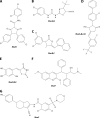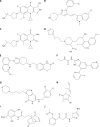Challenges of antibacterial discovery
- PMID: 21233508
- PMCID: PMC3021209
- DOI: 10.1128/CMR.00030-10
Challenges of antibacterial discovery
Abstract
The discovery of novel small-molecule antibacterial drugs has been stalled for many years. The purpose of this review is to underscore and illustrate those scientific problems unique to the discovery and optimization of novel antibacterial agents that have adversely affected the output of the effort. The major challenges fall into two areas: (i) proper target selection, particularly the necessity of pursuing molecular targets that are not prone to rapid resistance development, and (ii) improvement of chemical libraries to overcome limitations of diversity, especially that which is necessary to overcome barriers to bacterial entry and proclivity to be effluxed, especially in Gram-negative organisms. Failure to address these problems has led to a great deal of misdirected effort.
Figures








References
-
- Ackermann, B. L., B. T. Regg, L. Colombo, S. Stella, and J. E. Coutan. 1996. Rapid analysis of antibiotic-containing mixtures from fermentation broths by using liquid chromatography-electrospray ionization-mass spectrometry and matrix-assisted laser desorption ionization-time-of-flight-mass spectrometry. J. Am. Soc. Mass Spectrom. 7:1227-1237. - PubMed
-
- Adamek, R. J., S. Suerbaum, B. Pfaffenbach, and W. Opferkuch. 1998. Primary and acquired Helicobacter pylori resistance to clarithromycin, metronidazole, and amoxicillin—influence on treatment outcome. Am. J. Gastroenterol. 93:386-389. - PubMed
-
- Agarwal, A., S. Louise-May, J. A. Thanassi, S. D. Podos, J. Cheng, C. Thoma, C. Liu, J. A. Wiles, D. M. Nelson, A. S. Phadke, B. J. Bradbury, M. S. Deshpande, and M. J. Pucci. 2007. Small molecule inhibitors of E. coli primase, a novel bacterial target. Bioorg. Med. Chem. Lett. 17:2807-2810. - PubMed
-
- Ali, A., G. E. Taylor, K. Ellsworth, G. Harris, R. Painter, L. L. Silver, and K. Young. 2003. Novel pyrazolo[3,4-d]pyrimidine-based inhibitors of Staphylococcus aureus DNA polymerase III: design, synthesis, and biological evaluation. J. Med. Chem. 46:1824-1830. - PubMed
-
- Allen, N. E. 2010. From vancomycin to oritavancin: the discovery and development of a novel lipoglycopeptide antibiotic. Anti Infect. Agents Med. Chem. 9:23-47.
Publication types
MeSH terms
Substances
LinkOut - more resources
Full Text Sources
Other Literature Sources
Medical

